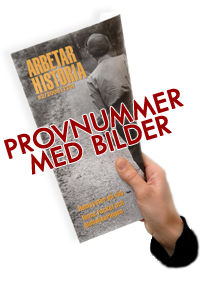Abstracts for issue no 129-130
Class and Scandinavian immigrants in Two Harbors, Minnesota / Jimmy Engren
The purpose of this article is to present perspectives on how a multi-ethnic working class public sphere emerged in the railroad town of Two Harbors, Minnesota during the 1910s and how Swedish, Finnish, Norwegian, and native-born workers played important parts in that process. A newspaper, entertainments, ethnic festivities and public celebrations were important expressions of this working class public sphere which was intimately connected to a culture of opposition where a multi cultural working class challenged the cultural, political and economic leadership of the Anglo-American bourgeoisie and its representatives and class allies in Two Harbors. The culture of opposition got its most forceful expression in the celebration of the Fourth of July 1915, where the working class of Two Harbors displayed their own identity project as an alternative to a monolithic Anglo-American identity. In the article I argue that it is possible to relate the events in Two Harbors and the emergence of a radical, ethnic working class identity to the move for Americanization of immigrants and the de-radicalizing of the American working class during the First World War as the Americanization project had as one of its main purposes to reconciliate class differences and to push for an American identity that would cut both across class lines and ethnic boundaries.
Transatlantic friendship. The international network of transatlantic feminism after World War II / Dorothy Sue Cobble
This article explores the international dimensions of the story of U.S. labor feminism, recreating the transnational networks and international organizations in which labor feminists participated. Part of this project involves delineating the transatlantic connections between U.S. labor feminists and their counterparts abroad and the intellectual influence European and Nordic social justice feminism had on U.S. social policy in the post-World War II era. Many of the most prominent twentieth-century U.S. women reformers were deeply involved in transatlantic political and social networks, including Esther Peterson and others such as Swedish immigrant and shoeworkers’ union president Mary Anderson, the first director of the U.S. Women’s Bureau and the longest-serving top U.S. woman governmental official in the interwar period.
The Swedish 20th century discourse on household work - an historical perspective / Emma Strollo
This article focuses on waged domestic work in a Swedish, historical perspective. The aim is to look at how conceptions about gender, class and “race”/ethnicity have been reproduced in legislation and in the debate on domestic work and how this might have led to reproducing unequal divisions on the market for domestic services. An intersectional approach is used in order to discuss the consequences of the gendered, racialised and classed nature of domestic work. From this perspective the article focuses firstly on the actions taken by the Swedish state when a shortage of domestic workers occurred in the 1930’s. The second and main focus is on what has been called the “maid debate” which started in 1993. Here, the article focuses on discourses on gender, class and “race”/ethnicity in the Swedish parliament debate. With examples taken from the debate it is argued that the debate on paid domestic services mirrors unproblematized intersecting hierarchies of sex, class and “race”/ethnicity. Despite the fact that gender equality has been one of the most common arguments in the debate on tax reductions for domestic work it is shown that these intersecting power relations are still being reproduced. Even though Sweden has a pioneer status when it comes to gender equality, one can see that when it comes to domestic work - there isn’t much that have changed in the view on who it is that should be cleaning for whom.
Olof Palme, the CIA and Poland / Klaus Misgeld
Although the independent trade union Solidarnosc on the 13th of December 1981 was banned by the Polish government, the international support for the organisation was upheld. Legal humanitarian aid as well as illegal transports of, for instance, literature and communication equipment, was organised until 1989. According to the book Victory (1994) written by American Journalist Peter Schweizer, a collaboration between CIA and Sweden was established with active support from Olof Palme, including these illegal actions. This view has been adopted by Swedish historians (2002-2005). But does it hold thorough scrutiny?
There is no hard evidence to support Schweizer’s statements and no exact time for the alleged arrangements can be specified. In spite of this fact, Swedish researchers have used his book to, firstly, establish the date for the talks between Palme and the head of the CIA, William Casey, to the 12th of October 1982, which would have resulted in a promise of Swedish support and, secondly, to further speculate on circumstanses and consequences, all with the purpose to describe Sweden as a “western” country on the side of the USA in the struggle against the Soviet empire. There are, however, circumstances contradicting this theory: the timing is unlikely, and such a promise from Olof Palme, entailing illegal actions from his own side and encouraging illegal actions from the side of Swedish customs officials, cannot be proved. Be that as it may, Sweden was used as a transit country for shippings to Poland and Solidarnosc that were financed by the US, in collaboration with Swedish and polish activists. But that is quite another story.
Communism and Nazism in a local community / Tage Alalehto & Mats Johansson
The article explores the question of why the Communist Party was so successful in Båtskärsnäs while the Social Democratic Party came to dominate in Karlsborg in the 1920s. It also investigates why the Nazi parties had such an exceptional success in Tärendö in the 1930s. Despite similar institutional factors between the two sawmills and between Tärendö municipality and other municipalities in the region, differences in political preferences among the citizens were obvious. To understand, and somewhat explain, these differences the article argues that institutional factors are insufficient. To fully understand the differences we need to consider how context-bound cultural values and the conduct of certain individual actors impact political preferences in different communities.


